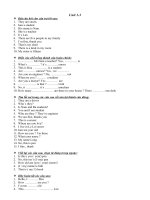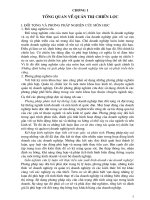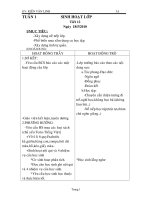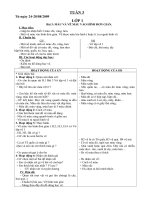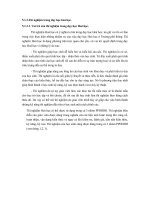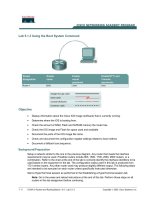- Trang chủ >>
- Mầm non - Tiểu học >>
- Lớp 5
5 1 3 harvesting medicine on the hill TG
Bạn đang xem bản rút gọn của tài liệu. Xem và tải ngay bản đầy đủ của tài liệu tại đây (106.83 KB, 4 trang )
Harvesting Medicine
on the Hill
SUMMARY
This story is about a Native
American boy and his grandfather from the
Chumash tribe. They take a journey to gather
healing plants because they are worried that
the new Spanish people settling in the area
will bring sickness to the Native American
tribes.
LESSON VOCABULARY
cultivated
ominous
quell
idly
purify
urgency
INTRODUCE THE BOOK
INTRODUCE THE TITLE AND AUTHOR
Discuss with
students the title and the author of Harvesting
Medicine on the Hill. Based on the cover
illustration, ask students to imagine what the
book will be about.
BUILD BACKGROUND
Discuss what students
know about different plants and their uses.
Ask them if they know plants that may harm
them, such as poison ivy. You may want to
prompt them with examples of plants that
have healing effects, such as aloe, which is
used to soothe burns.
PREVIEW/USE PHOTOGRAPHS As students
preview the book, ask them to look at the
photographs and guess what they think the
book will be about. Draw their attention to the
photograph on page 7. Ask them what clues it
gives about the book’s theme.
20
5.1.3
SETTING AND THEME
VISUALIZE
READ THE BOOK
SET PURPOSE
Have students set a purpose
for reading Harvesting Medicine on the Hill.
Prompt them to think about the important
healing effects of plants.
STRATEGY SUPPORT: VISUALIZE
As students
read, visualizing helps them better understand
what they are reading. The descriptions
on page 3 are excellent examples of vivid
descriptions that help the reader visualize
what is written. Have students read page
3 and discuss the images that these
descriptions bring to mind.
COMPREHENSION QUESTIONS
PAGE 4
What is the setting? (hills full of
wildflowers, weeds, and various plants)
PAGE 15 What words or phrases on this page
help you visualize the setting? (Beautiful,
twisted oaks make patterns against the yellow
grass and blue sky. The autumn sun releases
the rich smell of the grass.)
PAGE 18 What conclusion can you draw about
Red Hawk’s future responsibilities? (Possible
response: He will teach the others about the
healing benefits of plants.)
PAGE 20
What are the healing benefits of
toloache? (It strengthens the body, cleans the
blood, and dull one’s pain.)
PAGE 24 What is the theme? (Answers will
vary but may include: Natural ways of healing
have been with us for a long time and may be
threatened by modern civilization.)
Harvesting Medicine on the Hill
16924_LRD_TG_020-021 20
3/20/06 8:43:47 AM
REVISIT THE BOOK
READER RESPONSE
1. 1500s, a hill on the California coast;
answers will vary.
2. Possible response: way of life and fears
would be different; relationships would be
the same.
3. ‘ap means home because the context says
it is where he and the boy live; from the
grandfather’s urgency, you know idly means
to stand and do nothing
4. Possible response: Many will become sick.
EXTEND UNDERSTANDING
Discuss with students
the two main characters in this story, Bent
Oak and Red Hawk. Start a discussion
about each of the character’s traits. Prompt
students to point to places in the book that
tell about these traits.
RESPONSE OPTIONS
WRITING
Suggest students imagine what it
would be like to live in a time when there were
no drugstores or hospitals. Ask them to write
a list of ways they could stay healthy without
the use of today’s drugs. Prompt them to think
of things like eating fruits and vegetables and
exercising.
SCIENCE CONNECTION
Students can learn more
about the healing benefits of
plants by researching them on
the Internet or in the library. Encourage them
to use a graphic organizer to write a short list
of some of the plants they learn about and to
describe their healing benefits.
Skill Work
TEACH/REVIEW VOCABULARY
Have students look up each word in a
dictionary and write the definitions. Then
have them write the base word of each word
with suffixes. Ask them how adding a suffix
changes each word’s meaning.
Have students write each vocabulary
word and its definition on a sheet of paper.
Then have students write the words and
their definitions in their home language.
Ask them if there are similarities between
English words and words in their home
language.
TARGET SKILL AND STRATEGY
SETTING AND THEME Remind students
that setting is the time and place in which a
story occurs. As students read, ask them to
write down the setting of the story and have
them ask themselves if the theme depends
on the setting of the story. Remind students
that theme is the underlying meaning of a
story—a “big idea” that stands on its own
outside a story. As students read, have
them answer the following question: What
does the author want me to learn from
reading this story?
VISUALIZE Remind students that to
visualize is to create a picture in the mind.
As students read, prompt them to pay close
attention to imagery and sensory details.
Using a graphic organizer, have students
write words and phrases from the text that
help them visualize what is happening.
ADDITIONAL SKILL INSTRUCTION
DRAW CONCLUSIONS
Remind students that
drawing a conclusion is making a decision
after thinking about details or facts. As
they read, have students think about the
future of these Native American tribes. Ask
students what conclusions they can draw
about the future of the Native Americans in
this book, based on what they read.
Harvesting Medicine on the Hill
16924_LRD_TG_020-021 21
21
12/28/05 1:06:30 PM
Name
Harvesting Medicine
Setting and Theme
• Setting is the time and place in which a story occurs.
• Theme is the subject or idea that a story is about.
Directions Based on your understanding of Harvesting Medicine on the Hill, answer the
questions below.
1. What is the setting of the story?
2. What is the story’s theme?
© Pearson Education 5
3. Does the theme depend on the setting of the story? Why or why not?
22
16924_LRD_TG_022-023 1
12/28/05 1:06:49 PM
Harvesting Medicine
Name
Vocabulary
Directions Write each vocabulary word next to its definition.
Check the Words You Know
cultivated
ominous
quell
idly
purify
urgency
1. to clear from imperfection
2. the state of needing immediate attention
3. loosened the soil around plants
4. to quiet, pacify
5. foreboding
6. inactively
Directions Write four sentences using as many vocabulary words as you can.
7.
8.
© Pearson Education 5
9.
10.
23
16924_LRD_TG_022-023 2
12/28/05 1:06:50 PM

